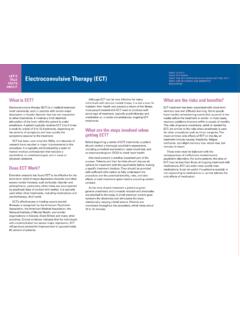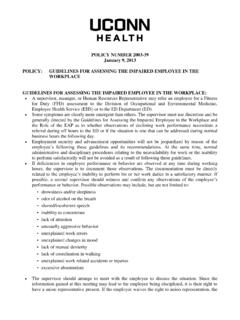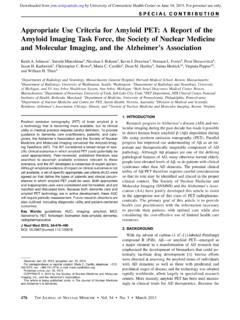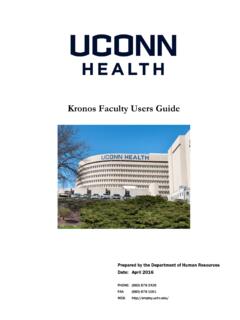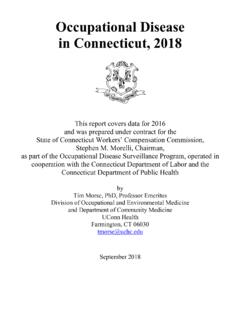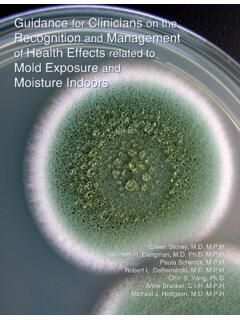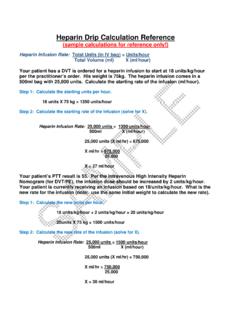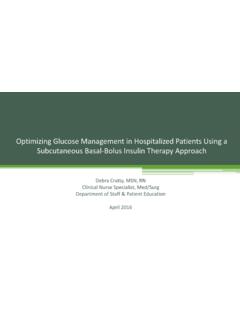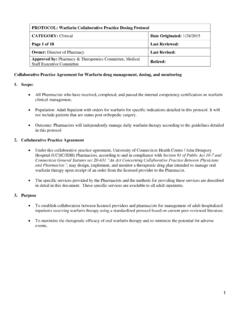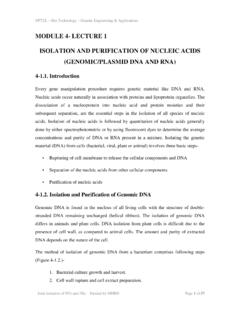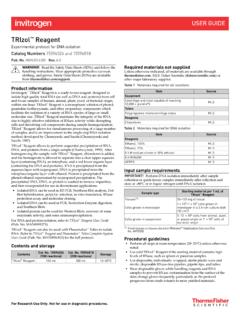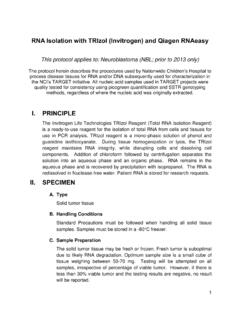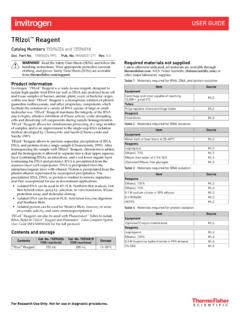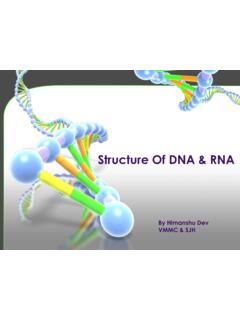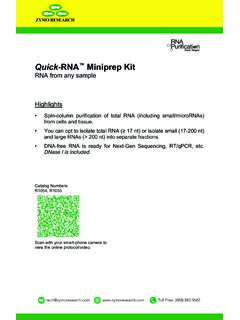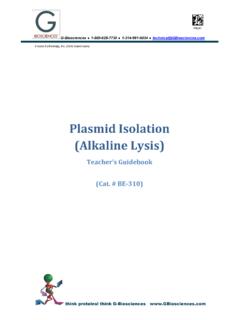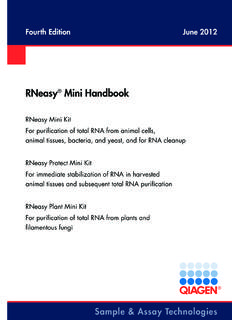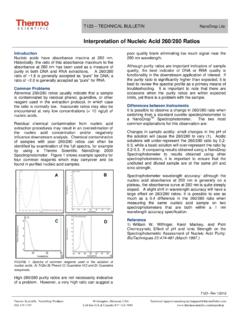Transcription of Total RNA extraction using Trizol reagent
1 Total RNA extraction using Trizol reagent 1. Homogenization 2. PHASE SEPARATION. Incubate the homogenized samples for 5 minutes at 15 to 30 C to permit the complete dissociation of nucleoprotein complexes. Add ml of chloroform per 1 ml of Trizol reagent . Cap sample tubes securely. Shake tubes vigorously by hand for 15 seconds and incubate them at 15 to 30 C for 2 to 3 minutes. Centrifuge the samples at no more than 12,000xg for 15 minutes at 2 to 8 C. Following centrifugation, the mixture separates into a lower red, phenol-chloroform phase, an interphase, and a colorless upper aqueous phase. RNA remains exclusively in the aqueous phase. The volume of the aqueous phase is about 60% of the volume of Trizol reagent used for homogenization.
2 3. RNA PRECIPITATION. Transfer the aqueous phase to a fresh tube, and save the organic phase if isolation of DNA or protein is desired. Precipitate the RNA from the aqueous phase by mixing with isopropyl alcohol. Use ml of isopropyl alcohol per 1 ml of Trizol reagent used for the initial homogenization. Incubate samples at 15 to 30 C for 10 minutes and centrifuge at no more than 12,000xg for 10 minutes at 2 to 8 C. The RNA precipitate, often invisible before centrifugation, forms a gel-like pellet on the side and bottom of the tube. 4. RNA WASH. Remove the supernatant. Wash the RNA pellet once with 75% ethanol, adding at least 1 ml of 75% ethanol per 1 ml of Trizol reagent used for the initial homogenization.
3 Mix the sample by vortexing and centrifuge at no more than 7,500xg for 5 minutes at 2 to 8 C. 5. REDISSOLVING THE RNA. At the end of the procedure, briefly dry the RNA pellet (air-dry or vacuum-dry for 5-10 minutes). Do not dry the RNA by centrifugation under vacuum. It is important not to let the RNA pellet dry completely as this will greatly decrease its solubility. Partially dissolved RNA 6. samples have an A260/280 ratio < Dissolve RNA in RNase-free water or SDS solution by passing the solution a few times through a pipette tip, and incubating for 10 minutes at 55 to 60 C. (Avoid SDS when RNA will be used in subsequent enzymatic reactions.) RNA can also be redissolved in 100% formamide (deionized) and stored at -70 C (5).
4 RNA isolation Notes: 1. isolation of RNA from small quantities of tissue (1 to 10 mg) or Cell (102 to 104) Samples: Add 800 l of Trizol to the tissue or cells. Following sample lysis, add chloroform and proceed with the phase separation as described in step 2. Prior to precipitating the RNA with isopropyl alcohol, add 5-10 g RNase-free glycogen (Cat. No 10814) as carrier to the aqueous phase. To reduce viscosity, shear the genomic 2. DNA with 2 passes through a 26 gauge needle prior to chloroform addition. The 3. glycogen remains in the aqueous phase and is co-precipitated with the RNA. It does not inhibit first-strand synthesis at concentrations up to 4 mg/ml and does not inhibit PCR.
5 4. After homogenization and before addition of chloroform, samples can be stored at -60 to -70 C for at least one month. The RNA precipitate (step 4, RNA WASH) can be stored in 75% ethanol at 2 to 8 C for at least one week, or at least one year at 5 to -20 C. 5. Table-top centrifuges that can attain a maximum of 2,600xg are suitable for use in these protocols if the centrifugation time is increased to 30-60 minutes in steps 2 and 3.
